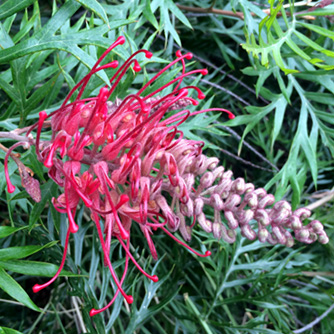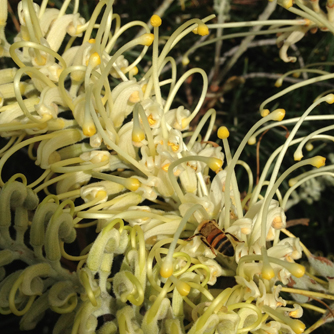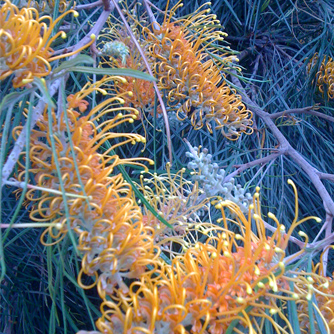Grevilleas
BackGrevilleas, named after Charles Francis Greville, are part of the Proteaceae family and are one of Australia’s most iconic native plants. There are over 350 species with countless more cultivars available. Flowers range in colours such as pink, cream, red, yellow, orange and even a mauve/purple flower – very trendy don’t you think?
Grevilleas in your garden will guarantee the arrival of nectar feeding birds such as honeyeaters, silvereyes and lorikeets. The bushy types also provide safe havens for finches and wrens. They are extremely long flowering plants with flowers that are brush-like or spider-like and usually with long prominent styles.
Grevilleas come in all shapes and sizes from ground covers to shrubs and trees. There are even grafted weeping standards which look spectacular in full flower. They are ideal for use in rockeries, as specimen plantings and also make great informal hedges.
Once established most Grevilleas are quite drought hardy and many will withstand frosts.
How to Grow Grevilleas
With so many different types of grevilleas available there are always exceptions to the rule but here’s a general guide to keeping your grevilleas happy.

Grevillea 'Robyn Gordon' produces these magnificent flower spikes all year
Grevilleas need good drainage or you run the risk of them developing root rot. If planting into heavy clay first improve the drainage by applying gypsum and then raise the soil level by mounding up the garden bed.
Plant grevilleas where they’ll receive plenty of direct sunshine. Some will tolerate a bit of shade but you usually end up with scraggy plants that suffer more often from insect attack. At least half a day of direct sun is best.
Grevilleas can be a bit finicky until they are established so apply OCP eco-seaweed in the first few weeks to settle the plant into its new home. If planted in spring ensure they have adequate water during their first summer.
Fertilising Grevilleas
Grevilleas will perform better if fertilised regularly but be mindful that they are sensitive to phosphorus. Regular fertilisers usually have levels of phosphorus which are too high and will result in plant death (sometimes this takes up to 12 months to actually occur). Only use organic fertilisers which state on the label they are safe for natives or that contain no more than 2% phosphorus.
OCP eco-aminogro is suitable for all natives including grevilleas. It contains only 0.4% phosphorus and encourages growth and health in plants. Apply every 2-4 weeks to young plants and watch them take off! Plus there’s the added bonus that you can mix it with eco–seaweed to get the very best from your plants AND save yourself some time.

Grevillea "Moonlight" with foraging bee
Pruning Grevilleas
Tip prune shrub varieties once a year to encourage dense bushy growth. This is best done at the end of spring after the main flush of flowers has finished but it can also be done in autumn.
Pest & Disease Problems
Grevilleas are generally trouble free plants provided they are growing in free-draining soil and receive enough sunlight.
Watch out for various scale insects which attack grevilleas and are often not easy to see until the infestation has spread over the whole plant. The presence of sooty mould is also a clear indication of scale being present. Spray with a horticultural oil to control the scale. Sooty mould can be controlled with OCP eco-oil.
If the drainage is poor then grevilleas can quickly suffer from root rot diseases, like phytophthora. Typically the grevillea will look thirsty with leaves quickly turning brown and usually clinging to the branches. Extra watering doesn’t fix the problem and the plant usually dies in a short period of time. Prevention is the best approach by improving drainage issues before planting.
Yellowing of new growth and scorching of leaf edges could be a sign of phosphorus toxicity. As mentioned above only use native safe fertilisers to avoid the problem. Regular applications of OCP eco-seaweed may be helpful if you are already experiencing this problem.

Birds, like this Eastern Spinebill, are also attracted to grevillea flowers
Our 10 Best Grevilleas
There are so many to choose from but some of our favourites are :
Groundcovers for rockeries and embankments
- Grevillea ‘New Blood’ – grows 25cm high x 1.5m wide with red flowers for most of the year
- Grevillea ‘Royal Mantle’ – grows to a massive 5m wide but only 20cm high with red toothbrush style flowers in winter and spring
- Grevillea ‘Pink Midget’ – grows 30cm high x 1m wide with pale pink spider-like flowers
Medium shrubs suitable for garden beds and informal hedges
- Grevillea ‘Purple Haze’ – grows in a compact shape with fabulous mauve/purple flowers over a long period
- Grevillea ‘Robyn Gordon’ – grows 2m x 2m with red brushlike flowers year round
- Grevillea ‘Peaches & Cream’ – grows 1.5m wide x 2m high with cream flowers that turn to pink
- Grevillea ‘Golden Lire’ – grows 1.5m wide x 1m high with yellow flowers all year
Screening
- Grevillea ‘Marmalade’ is an excellent informal screening plant that can take part shade. 3m x3m with orange and black spider-like flowers.
Trees
- Grevillea ‘Moonlight’ – grows 5m x 5m with large cream brush-like flowers all year
- Grevillea ‘Honey Gem’ – grows 5m wide x 4m high with orange brush-like flowers in winter and spring

Grevillea "Honey Gem"


